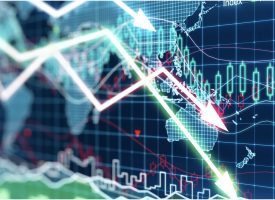On the heels of some wild trading recently in global markets, Tom McClellan, Art Cashin, Peter Boockvar all weigh in, plus a shocking chart.
Staggering Amounts Of Business Debt
May 21 (King World News) – Peter Boockvar: There was nothing market moving in the comments last night from Jay Powell but he did spend time talking about excessive levels of corporate debt.
“The acronyms have changed a bit, ‘CLOs’ instead of ‘CDOs’, for example, but once again, we see a category of debt that is growing faster than the income of the borrowers even as lenders loosen underwriting standards. Not only is the volume of debt high, but recent growth has also been concentrated in the riskier forms of debt.”
Total Business Debt As % Of US GDP Near All-Time Highs

He’s not worried about the impact to the bank lenders because of better balance sheets but instead “the level of debt certainly could stress borrowers if the economy weakens.”
You didn’t think I’d go without commenting on this did you? So the Fed’s main function for the economy by shifting rates is to encourage borrowing when they cut and to discourage it when they hike. Now after an extraordinary run of cheap money that has resulted in record high business debt levels, Fed members (Dallas Fed President Robert Kaplan is another one that is rightly highlighting the risks) are now expressing concerns with it. What will be their response function in the next economic downturn, cut rates from what are already very low rates and then encourage even more borrowing. Tough spot, I agree…
BONUS INTERVIEW:
To listen to billionaire Eric Sprott discuss his prediction for skyrocketing silver
as well as his top silver pick CLICK HERE OR BELOW:
Home Depot, a focus of mine from an informational perspective with respect to SALT cap impact, not a stock positioning standpoint, reported a better eps quarter but missed comp store sales estimates by almost half. In their press release they cited “unfavorable weather in February and significant deflation in lumber prices compared to a year ago” as the reasons for the comp miss. With respect to the influence of the SALT cap, it’s really tough to quantify and hopefully in the conference call they will give a regional viewpoint on sales so we can speculate on any impact.
Aussie Dollar Hits Lowest Level Since January 2016
The Aussie $ is falling vs the US dollar to just shy of the lowest level since January 2016 after comments from RBA Governor Philip Lowe. From an already record low level of rates at 1.5% he said:
“A lower cash rate would support employment growth and bring forward the time when inflation is consistent with the target. Given this assessment, at our meeting in two weeks’ time, we will consider the case for lower interest rates.”
Tweaking rates from an already low level to try to fine tune inflation which no central bank ever has had success in doing? Hubris in this already over leveraged economy.
Further Slowing In Global Trade
There was further slowing in global trade in May as seen in South Korea’s numbers. Exports for the first 20 days of the month fell by 11.7% y/o/y and which marks the 5th straight month of declines. Semi’s make up approximately 20% of South Korea’s exports and they fell by 33%. South Korea will not be able to escape the spat between the US and China as their exports to China fell by 16%. The Korean Won is little changed but is just slightly below its lowest level vs the dollar since early January. The Kospi was up almost .3%.
Meanwhile, In Europe…
Shifting to Europe, the UK CBI industrial orders index for May fell to -10 from -5 and that is below the estimate of no m/o/m change. That’s the weakest print since October 2016. The export component fell to the least since July 2016. CBI said:
“These results provide further evidence that manufacturers have been stockpiling at a rapid pace as part of their Brexit contingency plans. When combined with a sharp decline in order books, it’s clear why manufacturing firms are so keen to see a swift end to the current Brexit impasse.”
So looking past the stock piling (where 35% of manufacturers say they have more than enough, the most in 10 yrs):
“business surveys suggest that underlying conditions remain more subdued, as Brexit uncertainty and slower global growth bite further on activity.”
Bottom line, the UK economy has performed much better than many anticipated after the Brexit vote but at this point the uncertainty is death by a thousand cuts from the perspective of those companies that do business with the EU. Along with many currencies vs the dollar over the past few weeks, the pound is down for the 10th day in the past 12.
Also of importance…
From legend Art Cashin: A Word From The Wise – The always insightful Tom McClellan recently opined on potential cyclical pattern conflicts that may be facing the market currently. Here’s a bit of what he wrote:
The stock market started the week in a grumpy mood, as the hopes for a pleasant agreement with China over trade keep getting more remote. Semiconductor stocks got hit hard, dragging down the Nasdaq 100 more than the other indices. The SP500 fell for a second day, and seemingly has its sights set on retesting the 2800 level where support was found in March and again last week.
In the process, the four moving average type lines keep drawing closer together. And we have the troubling prospect that we are seeing a Type 2 rainbow convergence. That’s when prices retrace back toward the pricetime point of an impending convergence, and the implication is that the trend direction preceding the retracement should resume itself. In this case, that would mean downward.
But that goes against what the Presidential Cycle Pattern says should happen in the 3rd year of a presidential term. It says we get one May dip, and then upward. This time the May dip arrived a little bit earlier than normal, but so were other structures of the recent uptrend.
The Presidential Cycle Pattern (not shown) averages together the market’s behavior in 4-year chunks of time. The same principle is employed with the Annual Seasonal Pattern (ASP), but it uses 1-year time chunks. The ASP is shown in the top chart on page 2, and it was working pretty well leading up to the month of May.
The intrusion of China trade worries into the minds of investors appears to have bent the market lower in an atypical way. It wiped out the second top which was due May 14. Unlike the Presidential Cycle Pattern with its single May dip, the ASP says that prices are supposed to chop around for a lot longer.
My presumption has been that the 3rd presidential year’s more positive story would be more likely to play out, especially given how strong the market has been earlier this year, and how breadth numbers are still generally strong. But the China trade negotiations are a big wild card which the charts cannot fully get us around.
What I have noticed lately (and others are starting to see it too) is that the selling generally comes overnight, and does not get added to during the regular trading day. That means U.S. investors’ demand for stocks is still there, and that is usually a big positive sign.
My expectation remains that we are going to see a market upturn which turns up the SP500’s Price Oscillator, and which thereby moots the question of whether this is a Type 2 convergence as discussed on page 1. That would take a 44-point rise in the SP500 Index on Tuesday to accomplish, but that task of climbing back above the Price Oscillator Unchanged line could get broken up into several days.
You can hardly get much clearer than that.
***KWN has now released the powerful audio interview with Andrew Maguire discussing the gold and silver takedown and what to expect next and you can listen to it by CLICKING HERE OR ON THE IMAGE BELOW.
***Also just released: US Dollar And Treasuries Plus A Key To The Gold Market CLICK HERE TO READ.
 © 2019 by King World News®. All Rights Reserved. This material may not be published, broadcast, rewritten, or redistributed. However, linking directly to the articles is permitted and encouraged.
© 2019 by King World News®. All Rights Reserved. This material may not be published, broadcast, rewritten, or redistributed. However, linking directly to the articles is permitted and encouraged.








